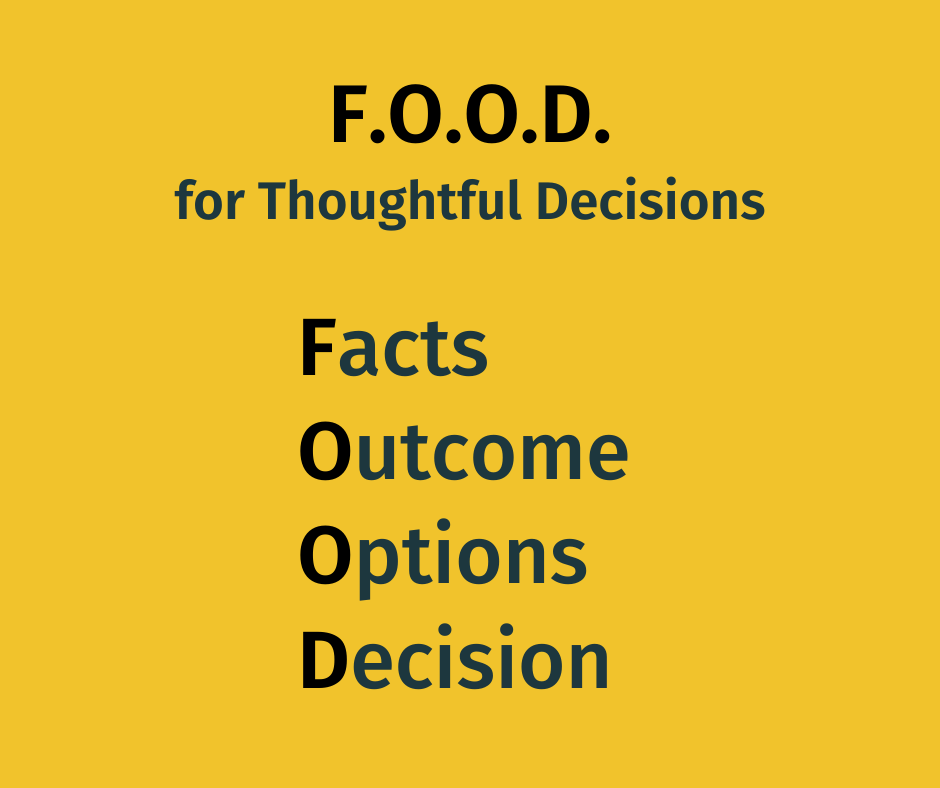This was not the way it was supposed to be. I was not happy with the editing they did for my video. The question was, what should I do about it? Or more accurately, What is the wise thing to do?
The essence of wisdom is quality decision-making. We all make decisions all day, every day (consciously or unconsciously). We are, in fact, decision-making factories. Isn’t it crazy that most of us never learned how to make wise decisions? Let me share a simple, four-step process that research says improves the quality and consistency of decisions. It is F.O.O.D. for thoughtful decision-making. It certainly helped me solve my video conundrum.
The Four Simple Steps of Wise Decision-Making
1. Facts
What are the relevant Facts?
Decisions are always made in a given context. Therefore, it's best to begin decision-making by brainstorming the relevant facts surrounding the environment. One of the ’facts’ that bubbled up concerned whether better editing would actually improve the video. That's why I invited several truth-telling colleagues to view the video. The consensus was that the video was an eight, on a scale of 1 to 10, and that better editing could make it a nine. Other relevant facts included: I might not be able to get the raw video footage; if I did get the footage, it would be costly (time and money) to edit; the video would be online for a long time; I believe in quality…
2. Outcomes
What Outcome is desired?
After you gather all the relevant facts, identify what you actually want as an outcome. Far too often, we are not clear about what we want to happen as a result of our decision. The outcome I wanted regarding my video was improved quality (from an 8 to a 9) via better editing.
Consider a leader I was coaching who asked me to help her with a difficult personnel issue. After we brainstormed relevant facts regarding her situation, she told me her goal was to make sure her poorly-performing manager understood what she expected of him. "Really?" I asked, "Don't you really want your direct report to improve her performance as a result of your meeting? Isn't that the outcome you want?" She smiled and agreed.
3. Options
With whom should you engage in brainstorming Options?
Two-time Nobel Prize winner Linus Pauling pointed out that "the best way to have a good idea is to have lots of ideas." When you’re making an important decision, it’s often helpful to invite key stakeholders to help you brainstorm your options? For example, John F Kennedy (JFK), president of the United States in the early 60’s, convened a committee to help him decide how to handle the Cuban missile crisis. He demanded that they generate numerous options before deciding that a naval blockade would be the best way to avert a nuclear war with Russia. It worked!
I brainstormed different options with a few colleagues to address my video problem. These included: e-mailing John, the director responsible for editing, a list of changes I wanted; sending me the raw video footage so I could edit; calling John and inviting him to review my video with me; e-mailing him for an appointment to discuss my concerns. I chose this last option.
4. Decide
Decide which option will best achieve your outcome.
As you select your option, consider asking one of the wisest questions in all of science, “How do you know that option will get you what you want?” This question seeks the evidence, research, data, best practices… that substantiate your decision. Another way of asking that question is, “What makes you think the option you chose will achieve the outcome you desire?”
Trying to resolve difficult issues via e-mail seldom works. Instead, best practices suggest direct communication (via telephone, zoom, or in-person) has a better chance of achieving our goals. That's why I decided to e-mail John for an appointment to discuss (over the phone) my concerns about the video editing. When we spoke, he concluded our conversation by inviting me to provide him with a minute-by-minute list of editing changes I wanted. He promised to give them to his video editor. Yahoo!
I applied the F.O.O.D. Model to help turn my TEDx video from an eight to a nine (according to my colleagues). How can you and your team, at home and work, use it to make wise decisions consistently?

